Media | Articles
The Exhaust Problem (Part 1)
As I wrote last week, I bought a 2008 Nissan Armada to have as a keep-it-in-the-driveway-until-you-need-it tow vehicle/stuff-hauler/snowmageddon chariot. At $3250, it was cheap, but a few problems were baked into that price, one of which was a leaky exhaust that wasn’t loud enough for me to hear but was apparent when I held my gloved hand over the tailpipe.
A tight exhaust should pretty much push your gloved hand off, but one with substantial leaks one won’t offer any resistance at all. So I bought it knowing it needed exhaust work. The question was, how much? The tried-and-true triage method is to visually examine the entire length of the exhaust as well as block off the tailpipe with a cut-off inner tube and a hose clamp and carefully run your hands close to all exhaust surfaces to feel for leaks, but I was unable to do either of those things on the seller’s muddy dirt-and-gravel driveway.
Let’s put on our rose-colored glasses for a moment. Back in the golden pre-emission-control days, most exhaust systems consisted of a cast-iron exhaust manifold that likely lasted the life of the car, and four normal-wear-and-tear components—the headpipe that bolted to the manifold, the center resonator, the muffler, and possibly a separate tailpipe. These components were interconnected by flanges sealed by either gaskets or crush rings, and held together with simple nuts and bolts. Replacing isolated sections was usually easy. If the exhaust got loud, you crawled under the car, figured out which section was rotted out, bought another one, installed it—boom, done. Yeah, OK, some exhaust sections were fitted by sliding one tube inside another and U-clamping them together, and over time, rust would fuse the sections making replacement difficult, but if you were careful you could usually manage it.
As vintage cars age, though, it’s common for them reach the point where, if one component is rusted through, the smart thing is to “just do it all” and replace the entire exhaust, meaning everything except the manifold. The reason is twofold. First, if one exhaust component is rusty enough to be ventilated, odds are that the others aren’t far behind. Second, it’s often challenging to get new components to seal against old ones. Some of this is unevenness on the sealing surface of the old component, some is that the flange size on a non-original replacement component is subtly different from that which it needs to mate with in the car. If it’s a car you’re keeping for the long term, buying and installing a new exhaust—be it original (if it’s still available), aftermarket, performance, stainless steel, or whatever—is often a good box to check off for a rejuvenation.
The other option is to go to a custom exhaust shop where they measure, bend, and install a system specifically for your car. I’m generally not a fan of this approach, as custom exhausts often have welded joints that make it difficult or impossible to drop the exhaust to, for example, remove a transmission. I had it done a few years ago in my little Winnebago Rialta RV because there was no other option.
Marketplace
Buy and sell classics with confidence
Things became more complicated when catalytic converters crept in in the mid-1970s, as the cat was an expensive additional component that could rust out and get loud, and it had an extra set of flanges that needed to seal to make the exhaust tight. V-configuration engines typically have a separate cat for each bank of cylinders. And many cars, including the Armada, are equipped with primary and secondary cats on each bank, for a total of four. This creates six flange joints where the cats can leak (manifold to primary, primary to secondary, secondary to the rest of the exhaust, on each side).
You can see why “just do it all” is not ever my go-to strategy on a modern car. It’s simply too expensive. If an exhaust and one or more cats needs to be replaced in a high-mileage 15-year-old car, the dealer estimate for the repair can easily exceed the car’s value, and the price from an aftermarket or custom shop can easily top a thousand dollars.
So, with that backdrop, let’s look at the Armada. The exhaust was porous enough that a rubber glove clamped over the tailpipe was enough to redirect all the flow through the holes, making them easier to find.
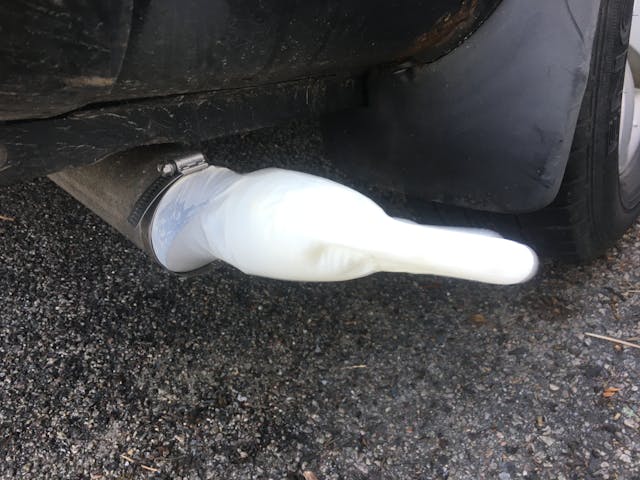
The Armada doesn’t have the ground clearance that my Silverado 3500HD did (which enabled its catalytic converter to get stolen, but also allowed me to replace it without lifting the truck), but the rear section of the exhaust is pretty accessible. I skooched under the back and quickly found a major leak where the tailpipe was attached to the muffler with the world’s worst weld. I bought a decent mig welder about five years ago but have never walked up the learning curve to use it properly, and I’m certain that if I attempted to re-weld the joint, it would look no better. I’ve certainly done my share of soup-can-and-hose-clamp exhaust repairs and tested one here with aluminum flashing, but the big bulge from the misaligned pipes and the weld didn’t give it a hope of sealing.
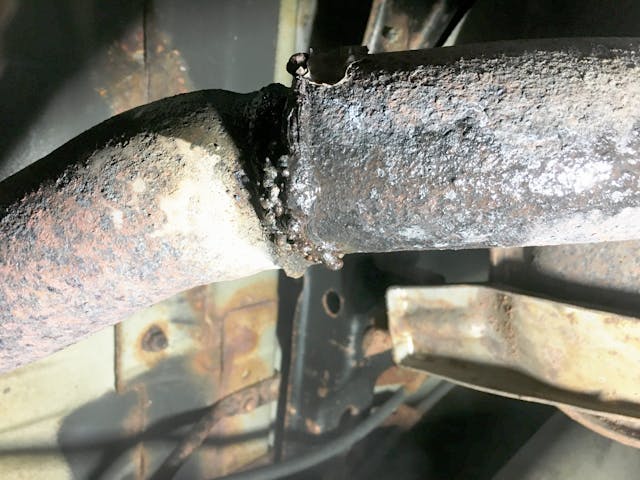
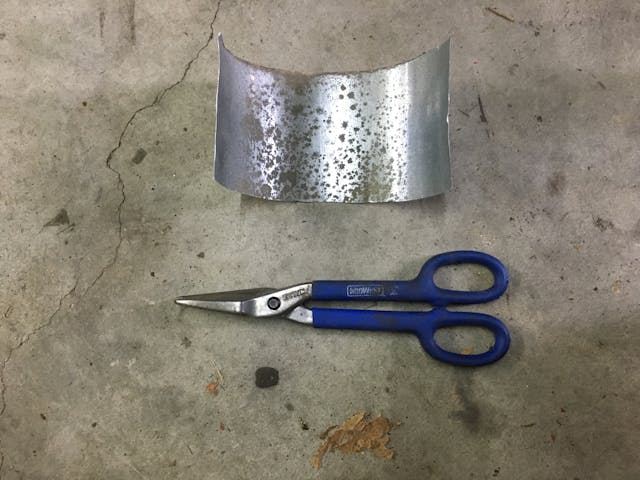
I’ve occasionally used a local exhaust shop to patch isolated leaks like this, so I took the Armada to them for a quote on fixing the tailpipe, thinking that maybe all it needed was a hundred-dollar splice-and-weld. Unfortunately—and not surprisingly—when they had it on the lift and inspected it, they found that the tailpipe was only one of three leaks. There was also a good-sized leak from the seam on the top of the muffler, and a small leak at the output flange of the right rear (secondary) catalytic converter. Unfortunately, the studs and nuts on that flange were decimated by rust, and the flange itself looked paper-thin. The shop’s recommendation was to cut off the flange and weld a new pipe from the back of the cat to a new muffler and tailpipe. The $1200 estimate wasn’t unreasonable, but it was more than I wanted to spend.

I thought about my options, all of which were limited by winter weather and my workspace. The Armada is big enough that, to fit it in my garage, I’d need to kick not one car outside, but two. That’s fine when the weather’s good, but I’m not going to let my 49,000-mile 1973 BMW 2002 sit outside in rain or snow, and due to the configuration of my narrow suburban driveway, which is hemmed in by my house and my neighbor’s high fence, when we get a lot of snow, there’s nowhere to blow it, so the garage can get snowed in for weeks.
So I tried the easiest path first—muffler paste. This stuff comes in a couple of forms. There’s muffler cement that’s intended to fill gaps and seal joints, and there’s muffler putty that’s intended to be more structural. I had a can of the latter in the garage, so I gave both the tailpipe and the top of the muffler a wire-brushing, then with a nitrile glove on my hand, shoveled the putty into and around the tailpipe weld and into the seam on the top of the muffler.
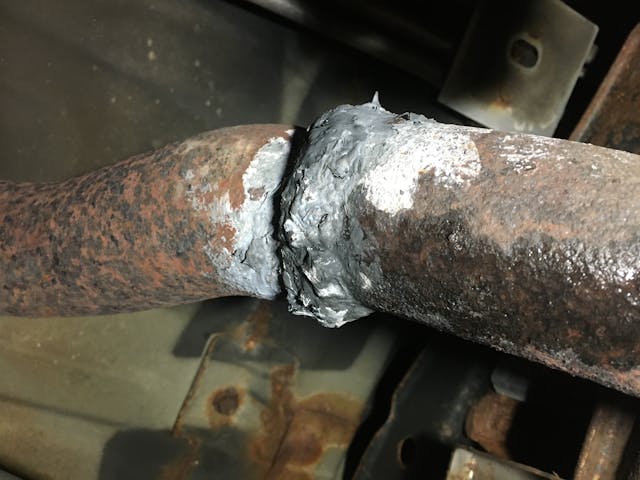
At this point, I need to explain a few things about Massachusetts’ draconian annual automotive inspection. I love my home state, but not this part of it. You’re required to have a vehicle inspected within seven days of purchase. It doesn’t matter if it already has a valid inspection sticker on the windshield. That’s not your sticker—it’s the previous owner’s. The sticker has the car’s plate number and VIN printed on it in small type, and a bar code that a police officer can scan and call up the registration. So if you’re driving on the old sticker, and you’re stopped for some reason and the officer checks the sticker, you’ll be cited for driving an uninspected vehicle, which is a moving violation that adds points to your license. There are rare reports of people even being ticketed for this when the car is parked. Plus, there is the safety part of the inspection and the emissions part. If you fail the emission part, you get a black “R” sticker with a 60-day grace period for you to get the car repaired, but if you fail for a safety reason, you get a red “R” sticker with no grace period—you can be pulled over any time and ticketed—and an exhaust leak is regarded as a safety issue. I’m uncertain exactly how they check for exhaust leaks, whether they do the hand-over-the-tailpipe test on every single car or only on cars that have loud-sounding exhausts.
So. I’d bought the Armada with a leaky but largely asymptomatic exhaust. The inspection sticker on the car was good through August, but it wasn’t my sticker. Legally I was required to get the beast inspected, but … should I? The risk was that it would fail and I’d lose the valid-looking sticker, be given a big red rejection sticker that’s far more visible (moving violation-wise), and have to spend real money replacing the exhaust.
I thought it over. The exhaust didn’t sound loud to me to begin with, and I’d patched the two big leaks, so it had to be quieter and better-sealed than before. Do it. Get it inspected. Cross it off the list. Be legal about it, as I am with most things these days. I brought it in.
Bad idea. It failed. I’d rolled the dice and lost. The car I’d bought to have around in case I needed to drop everything and buy something big now had a large red “R” on the windshield that could land me an expensive ticket.
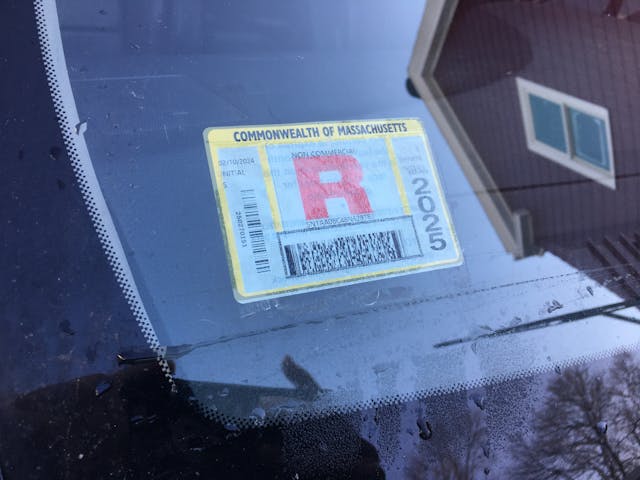
To make matters worse, a winter nor’easter was forecast to move in and dump 8–12 inches of snow, effectively cutting off access to my garage. And the logistics of major exhaust surgery on the Armada were daunting, as the vehicle’s weight is uncomfortably close to the 6000-pound limit of my mid-rise lift. I’d likely need to do the whole thing on the garage floor, which, at age 65 with back issues, didn’t sound like a lot of fun.
I still do essentially all my own work, but I realize that there are times when you need to, as they say, just pay the man (or woman). Was this one of those times? I wasn’t sure. It drives me crazy when I’m put in a situation where I need to pay someone 10 times what it would cost for me to do something myself.
I looked on RockAuto (you gotta love RockAuto) and found that there are several well-priced aftermarket cat-back exhausts available for the Armada, two of which are less than $200 shipped to my house. The question was the slippery slope of that secondary catalytic converter’s paper-thin rear-facing flange. Since I don’t weld, if that flange broke or wouldn’t seal, I’d need to replace that cat. I wanted to know what the cat’s front flange looked like (where it mates with the primary cat), but I couldn’t get under the car, so I stuffed my phone under and shot some pics. What I saw was concerning. The idea of a minor exhaust repair potentially cascading into replacing two catalytic converters made me want to consider my next steps very carefully.
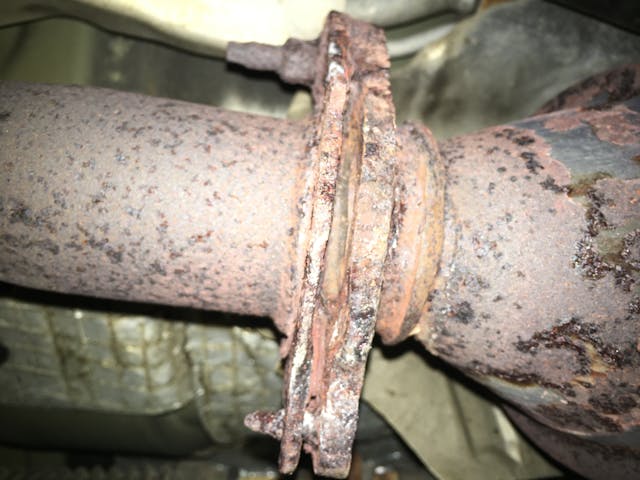
What’s a Hack Mechanic to do? Tune in next week in find out.
***
Rob’s latest book, The Best Of The Hack Mechanic™: 35 years of hacks, kluges, and assorted automotive mayhem is available on Amazon here. His other seven books are available here on Amazon, or you can order personally-inscribed copies from Rob’s website, www.robsiegel.com.
Check out the Hagerty Media homepage so you don’t miss a single story, or better yet, bookmark it. To get our best stories delivered right to your inbox, subscribe to our newsletters.
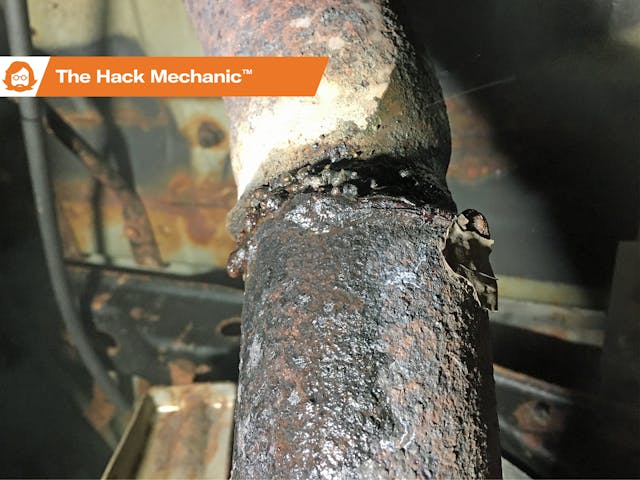

















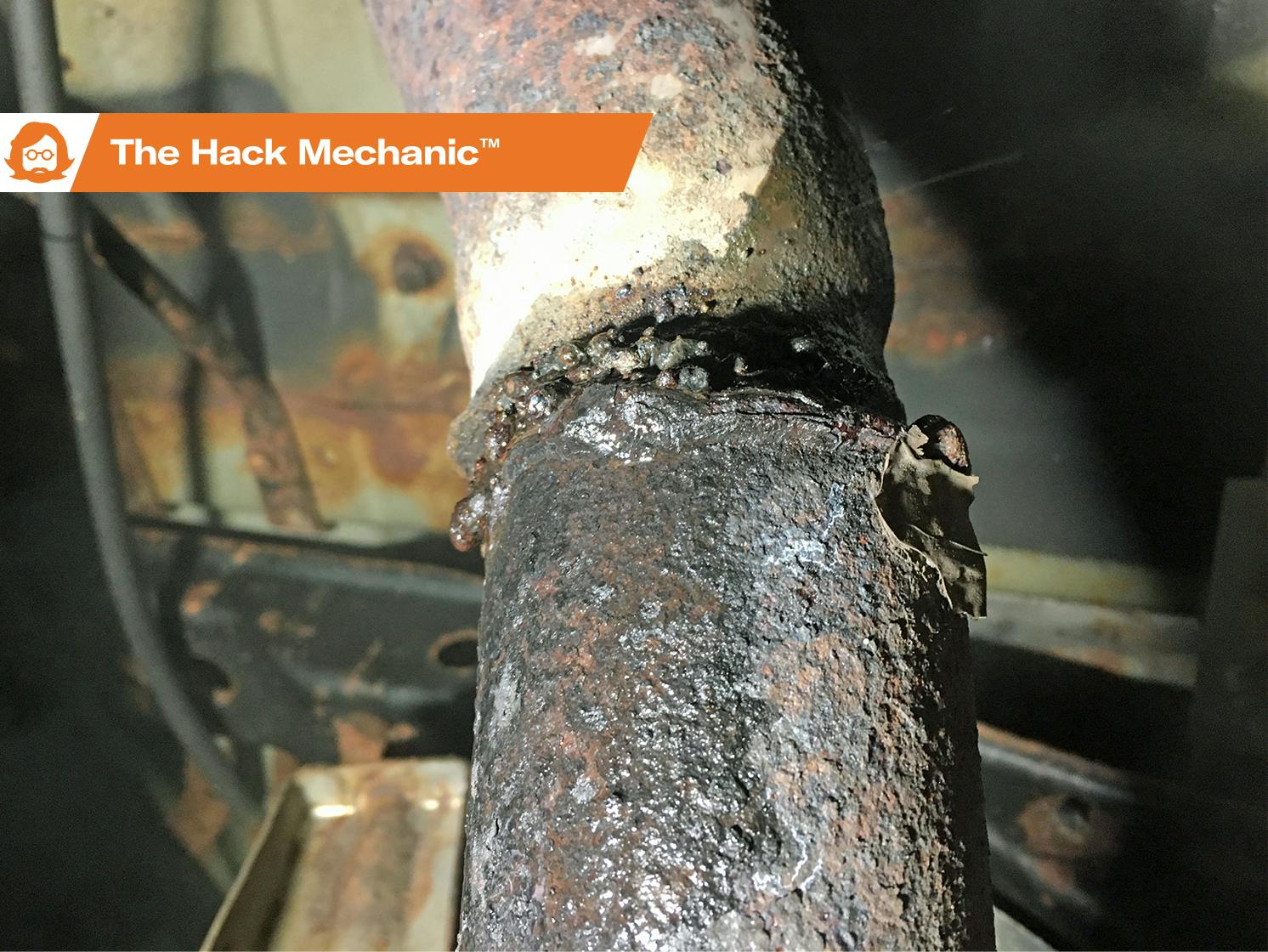
Move to another State without such ridiculous rules
I had a split at the exhaust on one of the factory welds and had an exhaust shop fix it. They said it would not last but it actually lasted pretty long.
First, you bought a cheap Nissan. A BIG one. You should know better. There is no such thing as a big, cheap Nissan. They rot, they can’t figure out how to do transmissions, and they don’t have the Chinese knockoff support that Toyota and Honda do. You should have known that you were one medium sized repair away from a totaled vehicle. “But” you protest “I can fix things!” Not in the great frozen tundra with which we deal, oh like half the year.
Your other mistake is living in Massachusetts. Here to your south, we call old vehicles ‘vintage’, neither inspect nor smog them, and as a bonus, you get a 50$ statutory property tax, as opposed to actual value, something that saves a boatload of money, even on 30k of modest collector cars.
Of course, I should be more charitable. My JDM Honda will need an exhaust soon, and I get to pay 475$ for miles of mild steel, plus shipping from the mother country. They do sell the shiny stainless ‘fart can’, but the less said about those the better.
Glad I’ve never had to live in “hot wrench country”. Personal nit for me is all the “expert muffler shops”, ya, like everyone is an expert body-man or painter. If you’ve ever had the privilege of dealing with a Real Muffler Shop, you know what I mean. The ones that make me laugh are nice builds listed for sale, & they hedged on the exhaust “system”, doesn’t make it to the back bumper, or it does & its exit is bazaar or has wonky exhaust tips. A clean exit for me is all the way back, tucked with no needed ornamentation.
Built in obsolescence was a term first bandied about in the 1950’s, but the Japanese really perfected the science since they came on the scene. Sure many of the cars and trucks last 300000 miles + without repair, but when things go South look out! The beauty of machines of yesteryear is (sometimes a plethora) of clearly defined issues which require attention, and a bunch of easy little cheap fixes is far more satisfying than one monster newer car “issue”.
Also don’t forget after spending time and money+ frustration on this beast even a perfect Armada can’t hold a candle to cruising around in a Lotus or BMW. Look at it this way: the world could easily do without another SUV from before 2010, bringing out another Europa would do others the joy of seeing something great reborn.
I love this ~ a buddy who knows I grew up in Rural New England and had a *very* rusty 1959 Ford F100 pickup in 1968, I’ve told him about my similar repairs, I can’t wait to see how this turns out .
-Nate
I have been successful on my 2007 Pontiac G5 by using bathroom-grade silicone caulking on leaking joints or holes or muffler shell where the attrition was in a limited area. My exhaust system is stainless pipes and aluminized shell steel muffler. Regardless of the stainless pipes, as you know, they gradually corrode over time. The proviso for silicone repair is it must be some distance away from the engine. The silicone is rated for 450 degrees F and works very well past the half-way or so distance along the exhaust. Too close to the cat or engine is too hot, even for Hi-temp automotive silicone . For good measure, I blend steel wool with the silicone and apply it by hand (with mechanics gloves) in and around the defect, building it up as necessary. Much better than commercial muffler cement and tape combos which tend to harden, crack, delaminate etc usually in less than a year. Key detail is to clean /etch the old metal with degreaser and something like Spray 9 Cleaner, and wire brush . I have extended the life on my exhaust system for the past 5 years with this technique. The car is now 17 years old, with 200,000 miles and the exhaust is still all-original except for some replacement hangers. Still, eventually, the day will come………
This was helpful as my kid is about to move to MA taking their 23 year old Protege. It’s a good runner with a solid body, but had a sketchy exhaust weld fail. I tried patching it with clamp on flanges. It’s quiet, but I’m sure it still leaks. Guess I’m going to pony up for the cat back parts.
Still not sure how an exhaust leak is a safety issue, but it doesn’t really matter. I’m thankful to live where there are no inspections.